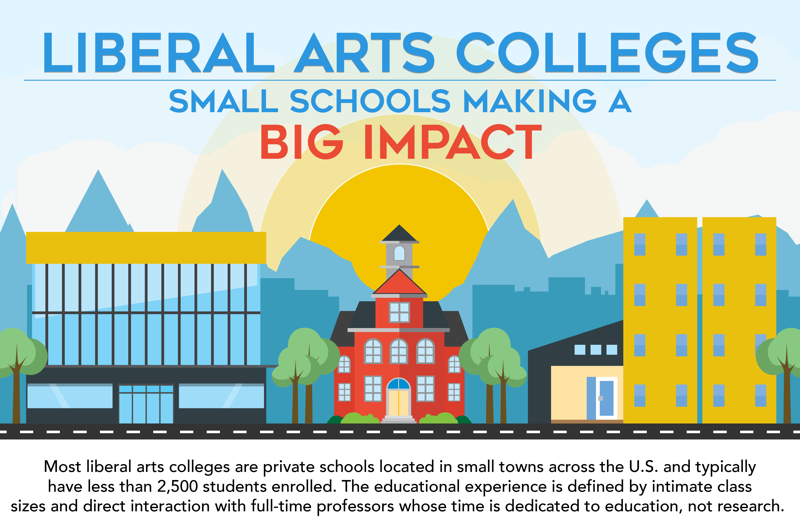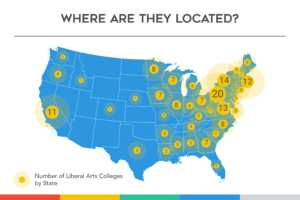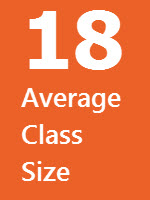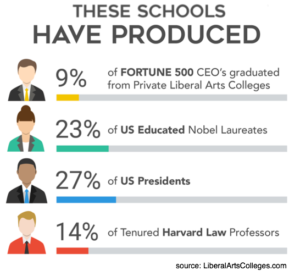
Liberal Arts Colleges that Change Lives and Make a Big Difference
When it comes to attention in the press, small liberal arts schools take a back seat to the large universities with huge alumni bases well-known athletic programs. Ask most parents what comes to mind in terms of the “best schools” and you’ll hear names such as Stanford, Notre Dame and University of Michigan. Of course, you may also hear about Ivy League schools but many students and parents disregard those schools as out-of-range in terms of possible college options.
What you don’t hear about is the small private liberal arts colleges. Say the names Occidental, Colby, Kenyon and Carleton and most people will respond with smile and usually a polite, “I don’t know about those schools.” What they really don’t know is the long history of providing personal attention to students and producing some the most successful college graduates on consistent basis.
Part of U.S. Success Both Past and Present
 Most liberal arts colleges are private schools located in small towns across the U.S. and typically have less than 2,500 students enrolled. The majority of these students will live on campus for all 4 years with their peers.
Most liberal arts colleges are private schools located in small towns across the U.S. and typically have less than 2,500 students enrolled. The majority of these students will live on campus for all 4 years with their peers.
These schools are mostly found east of the Mississippi River. Many of them were founded near the early American settlements, often in association with early churches.
Despite there being over one thousand colleges and universities in the USA, less than 200 of these institutions are private liberal arts colleges. Their graduates only make up 4 percent of all not-for-profit undergrads (for profit schools, such as Kaplan and University of Phoenix are not included in that number because they are considered schools for non-traditional college students).
And, even though these schools produce a small number of graduates each year, these graduates account for a much higher percentage of important roles in business, education and society, including 9 percent of Fortune 500 CEOs and 23 percent of US Presidents!
Small Classes and a Focus on Education, Not Research
The educational experience is defined by intimate class sizes and direct interaction with full-time professors whose time is dedicated to education, not research. The lack of graduate research (most of these small schools provide only undergraduate programs), enables professors to engage students directly on a regular basis. You won’t find teaching assistants running sessions on these campuses.
Although the numbers vary by school, the average class size is 18 students. What this means for students is that if they have a question, they can ask it in class and, by doing so, may generate the next level of  learning by starting a class discussion that takes a deeper look at the topic. This is in stark contrast to sitting in a lecture hall with hundreds of students, while the professor goes through his standard lecture on the topic.
learning by starting a class discussion that takes a deeper look at the topic. This is in stark contrast to sitting in a lecture hall with hundreds of students, while the professor goes through his standard lecture on the topic.
The small class size also means that, unlike students at large universities, liberal arts college students usually get to know their fellow students and professors well. Because of this, students will often connect with their peers and faculty outside the classroom, whether throwing the Frisbee around campus or sitting down for a cup of coffee.
Even in higher education, imitation is the sincerest form of flattery. Large schools now look to emulate the special experience that liberal arts college students get. Some large universities are creating “honors colleges” that include smaller class sizes, dedicated housing areas and a teaching staff focused on the undergraduate program.
A Practical Education for a Shifting Global Economy
Much has been written about the need for more vocational education so that a graduate’s first job out of school is a better
paying job. This dangerous notion assumes that starting salary is the best measure of an education and disregards the value of an education that positions students for long term career success.
A liberal arts education develops students into life long learners. The average person will change jobs 11 times in their
career and each change brings new technology, challenges and learning opportunities.
Employers surveys show they want graduates who know how to read, write and critically analyze information. They should be about to communicate in both verbal and written form and work well in teams. They should have a strong work ethic and be able to work through a detailed and difficult project from beginning to end.
In addition, in our now “flattened world,” exposure to other cultures is now critical to success. To complete a 4 year education within the borders of one state is to waste an opportunity to learn about other countries and how global economies are now intricately connected. For many liberal arts schools, an experience abroad is woven into the college experience.
Learning More About the Value of a Liberal Arts College Experience
We’ve created a detailed infographic that helps to demonstrate what the liberal arts colleges experience is all about explains the value that it provides students.
You can download the entire infographic by clicking the image below, then right click and “save as”…


